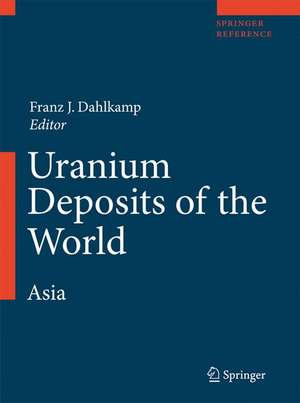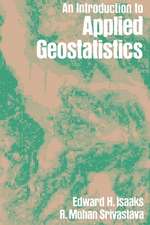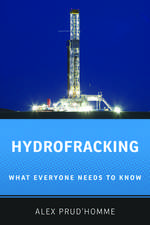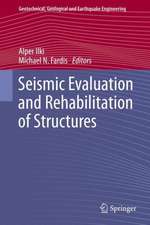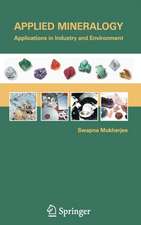Uranium Deposits of the World: Asia
Autor Franz J. Dahlkampen Limba Engleză Hardback – 15 sep 2009
With the first, the Asia volume Prof. Dahlkamp presents a complete uranium-resource reference based on the latest research and also gives access to previously unavailable data. The basic purpose, the presentation of an overview and data of uranium geology, is completed by a typological classification of uranium deposits using additional data from deposits worldwide. This classification forms the base for deposit descriptions throughout the three volumes, structured by countries.
Each country and region receives an analytical overview followed by the geologically- and economically-relevant synopsis of the individual regions and fields. The presentations are structured in three major sections: (a) location and magnitude of uranium regions, districts, and deposits, (b) principal features of regions and districts, and (c) detailed characteristics of selected ore fields and deposits. This includes sections on geology, alteration, mineralization, shape and dimensions of deposits, isotopes data, ore control and recognition criteria, and metallogenesis.
The volume also provides readers access to the voluminous literature via the comprehensive bibliography of uranium-related publications. Abundantly illustrated with information-laden maps and charts throughout, this reference work is an indispensable tool for geologists, mining companies, government agencies, and others with interest in key natural resources.
The three volumes of Uranium Deposits of the World are available as a set or individually. Also accessible (as a set and separate volumes) as a e-ref on springerlink.com. The originally planned fourth volume with Australia, Oceania, and Africa will not be published after the author suddenly deceased.
| Toate formatele și edițiile | Preț | Express |
|---|---|---|
| Hardback (3) | 1593.45 lei 38-44 zile | |
| Springer Berlin, Heidelberg – 15 sep 2009 | 1593.45 lei 38-44 zile | |
| Springer Berlin, Heidelberg – 19 aug 2010 | 1601.47 lei 38-44 zile | |
| Springer Berlin, Heidelberg – 8 aug 2016 | 2685.68 lei 38-44 zile |
Preț: 1593.45 lei
Preț vechi: 2096.64 lei
-24% Nou
Puncte Express: 2390
Preț estimativ în valută:
304.90€ • 319.20$ • 252.29£
304.90€ • 319.20$ • 252.29£
Carte tipărită la comandă
Livrare economică 01-07 aprilie
Preluare comenzi: 021 569.72.76
Specificații
ISBN-13: 9783540785576
ISBN-10: 3540785574
Pagini: 512
Ilustrații: X, 494 p. 180 illus. in color.
Dimensiuni: 210 x 279 x 37 mm
Greutate: 1.32 kg
Ediția:2009
Editura: Springer Berlin, Heidelberg
Colecția Springer
Locul publicării:Berlin, Heidelberg, Germany
ISBN-10: 3540785574
Pagini: 512
Ilustrații: X, 494 p. 180 illus. in color.
Dimensiuni: 210 x 279 x 37 mm
Greutate: 1.32 kg
Ediția:2009
Editura: Springer Berlin, Heidelberg
Colecția Springer
Locul publicării:Berlin, Heidelberg, Germany
Public țintă
ResearchCuprins
Preface.- Acknowledgments.- Remarks, Definitions, Units.- Part I Typology of Uranium Deposits.- Introduction .- Definitions.- Remarks.- Type 1 Unconformity-Contact U Deposits (Fig. 1).- Subtype 1.1 Proterozoic Unconformity-Contact U Deposits
(Athabasca type).- Subtype 1.2 Phanerozoic Unconformity U Deposits (Le Roube type).- Type 2 Proterozoic Subunconformity-Epimetamorphic.- U Deposits (Alligator Rivers type) (Fig. 2).- Type 3 Sandstone U Deposits (Fig. 3).- Subtype 3.1 Rollfront U Deposits (Russian terminology: Exogenic infiltration; Strata-oxidation).- Subtype 3.2 Tabular/Peneconcordant U Deposits.- (also referred to as Peneconcordant or Blanket deposits).- Subtype 3.3 Basal Channel U Deposits (Chinle type) (Russian terminology: Exogenic infiltration; Valley or Paleovalley, or U-REE in erosive paleovalley.- Subtype 3.4 Tectonic-Lithologic U Deposits.- Type 4 Granite-Related U Deposits (in Veins, Stockworks, and Episyenites) (Fig. 4).- Type 5 Volcanic U Deposits (in Veins, Stockworks, and Stratiform Lodes) (Fig. 5) (Russian terminology: Endogenic hydrothermal; Molybdenum-uranium, Apatite-uranium, or Fluorite-uranium deposits, or Deposits in volcanic depressions).- Subtype 5.1 U Deposits Associated with Mafic-Felsic Volcanics in Calderas Underlain by Granite (Streltsovsk type) (Russian terminology: Endogenic hydrothermal; Fluorite-uranium deposits associated with
andesite-rhyolite in erosional-tectonic basins) Subtype 5.2 U Deposits Associated with Felsic Volcanic Complexes.- Type 6 Metasomatite Related U Deposits (in Veins and Stockworks) (Fig. 6).- Subtype 6.1 Metasomatized granite (Kirovograd type).- Subtype 6.2 Metasomatized metasediments/metavolcanics (Zheltye Vody type) (Russian terminology: Ferro-uranium formation or Iron-uranium formation associated with
sodic and carbonate metasomatites).- Type 7 Undifferentiated (Meta-)sediment Hosted U Deposits (in Veins and Shear Zones) (Fig. 7).- Type 8 Collapse Breccia Pipe U deposits (Arizona Strip type) (Fig. 8).- Type 9 Polymetallic Hematite-Breccia-Complex U Deposits (Olympic Dam type) (Fig. 9).- Type 10 Paleoproterozoic Quartz-Pebble Conglomerate U Deposits (Fig. 10) (also referred to as Oligomictic conglomerate or
Lower Proterozoic conglomerate or Paleoconglomerate or Modified paleoconglomerate type).- Subtype 10.1 Monometallic (or U-dominant with REE) U Deposits (Elliot Lake type).- Subtype 10.2 Polymetallic Au with U Deposits (Witwatersrand type).- Type 11 Surficial U Deposits (Fig. 11).- Subtype 11.1 Duricrusted Sediments (also referred to as Calcrete, Silcrete, Groundwater-calcrete, or Valley-calcrete type) (Russian Terminology: Exogenic infiltration; Ground-oxidation).- Subtype 11.2 Peat-Bog (Flodelle Creek type).- Subtype 11.3 Karst Cavern (Pryor-Little Mtns. type).- Subtype 11.4 Surficial Pedogenic and Structure Fill.- Type 12 Intrusive U Deposits (Fig. 12).- Subtype 12.1 Alaskite U Deposits (Rössing type).- Subtype 12.2 Quartz-Monzonite/Copper-Porphyry Cu-U Deposits (Bingham type).- Subtype 12.3 Carbonatite Cu-U Deposits (Phalaborwa type).- Subtype 12.4 Peralkaline Syenite U Deposits (Kvanefjeld type).- Subtype 12.5 Pegmatite U Deposits (Bancroft type).- Type 13 Uraniferous Carbonaceous Shale-Related Stockwork Deposits (Ronneburg type) (Fig. 13) (Chinese terminology: Carbonaceous-carbonate-siliceous-pelite type).- Type 14 Uraniferous Bituminous-Cataclastic Limestone Deposits (Mailuu-Suu type) (Fig. 14) (Russian terminology: Exogenic epigenetic infiltration: Vanadium-uranium
deposits in carbonate sediments).- Type 15 Uraniferous Carbonaceous Lutite (Lacustrine) Deposits (Anderson Mine type) (Fig. 15).- Type 16 Uraniferous Organic Phosphorous Deposits (Mangyshlak type) (Fig. 16) (Russian terminology: Exogenic sedimentational- diagenetic; Rare-earth – uranium deposits in clays with fish remains) .- Type 17 Uraniferous Minerochemical Phosphorite Deposits (Idaho Phosphoria and Florida Land Pebble types) (Fig. 17) .- Type 18 Uraniferous Lignite/Coal Deposits
(Cave Hills and Freital types) (Fig. 18).- Type 19 Uraniferous Stratiform Black Shale Deposits (Ranstad and Chattanooga types) (Fig. 19).- Type 20 Uraniferous Synmetamorphic and Contact-metamorphic Deposits (Forstau and Mary Kathleen types) (Fig. 20).- References and Further Reading.- Part II Uranium in Asia – Overview.- China, Peoples Republic of .- Historical Review of Uranium in China.- Principal Characteristics and Distribution of Types of Uranium Deposits in China.- Description of Uranium Provinces, Regions and Districts in China.- Junggar-Tien Shan U Province, Xinjiang Uygur A.R., NW China.- Yili Basin.- Junggar Basin.- Turpan-Hami Basin.- Burqin Basin.- Kashi Depression/Northwest Tarim Basin.- North Tien Shan/Western Edge of Junggar Continental Block.- Yinshan-Liaohe U Province, NE China.- Liaoning U Region (Liadong Block), Liaoning.- Da Hinggan-Yanshan U Region, NE Inner Mongolia A.R. – N Hebei - W Liaoning.- Eren (Erlian) Basin, Central-north Inner Mongolia A.R..- Yingshan Basins, Inner Mongolia A.R..- Ordos Basin, Central-North China.- Qilian-Qinling U Province, Central China.- Longshoushan Uranium Zone, Gansu.- North Qinling Uranium Zone, S Shaanxi-SW Henan.- Lu-Zong Volcanic Basin, Anhui Province.- North Qilian Caledonian Fold Belt, Gansu-Ningxia Huizo A.R..- SW Qinling Metallogenetic Zone / South Qinling Hercynian-Indosinian Fold Belt.- South China Uranium Province.- Granite Dominated Domain/Granitic Complexes and Related U Deposits.- Volcanic Belts and Related U Deposits/Eastern Metallogenetic Domain.- Proterozoic-Paleozoic Terrane and Related C-Si-Pelite U deposits/Western U Metallogenetic Domain.- Mesozoic-Tertiary Basins in South China / Sandstone-Type
U Deposits.- West Yunnan U Province, Yunnan, SW China.- Gaoligong Region.- Lincang Region.- India.- Singhbhum Cu-U Belt, Jharkand.- Meghalaya Plateau, Meghalaya.- West Khasi Hills Region, Meghalaya.- Other Uranium Occurrences in the Meghalaya Plateau.- Meso-Neoproterozoic Cuddapah Basin, Andrha Pradesh, SE India.-Bhima Basin, Karnataka.- E Margin of Chattisgarh Basin/Sambalpur Granite Massif, Madhya Pradesh-Orissa.- Proterozoic Aravalli-Delhi Basins, Rajasthan.- Indonesia.- Remaja-Eko-Efka-Lemajun Rivers Area, Kalan Region.- Rirang River Area, Kalan Region.- Iran, Islamic Republic.- Bafq-Posht-e-Badam Zone.- Saghand Ore Field, Bafq District.- Gachin Salt Plug/Bandar Abbas Region.- Japan.- Tono Ore Field.- Ningyo-Toge Ore Field.- Other U Occurrences in Japan.- Kazakhstan.- Kokshetau Region, Northern Kazakhstan.- Ishimsky Ore Field, Southwestern Kokshetau Region.-Chistopolsky Ore Field, Southwestern Kokshetau Region.- Balkashinsky Ore Field, Southwestern Kokshetau Region.- Grachevsky Ore Field, Northwestern Kokshetau Region.- Altybaysky Ore Field.- Shatsky Ore Field, Northeastern Kokshetau Region.-Koksengirsky (or Zaozernoye) Ore Field, Central-Eastern Kokshetau Region.-Manybaysky Ore Field, Southeastern Kokshetau Region.- Shokay Zone, Olenty-Seletinsk Area, Eastern Kokshetau Region.- Other Uranium Occurrences in the Kokshetau Region.- Pricaspian (or Mangyshlak) Uranium Region, West Kazakhstan.- Karagiin Ore Field.- Chu-Sarysu Basin, South-Central Kazakhstan.- Kenze-Budenovskaya District.- Uvanas-Kanzhugan District.- Syr-Darya Basin, S Kazakhstan.- Karamurun District.- Karaktau District.- Kyzylkol-Chayan District.- Pribalkhash (Lake Balkhash)/Kendyktas-Chuily-Betpak Dala Region, SE Kazakhstan.- Northern Betpak Dala Area.- Central Chuily Area.- Southern Pribalkash Region.- Granitnoye Ore Field.- Ily Region, SE Kazakhstan.-Western Balkhash Basin / Nizhny-Ily Subbasin.- Ily Basin.- Zhalanshiksky Region, Central Kazakhstan.- Turgai-Priyrtish Region, Northern Kazakhstan.- Isolated Uranium Deposits / Occurrences in Kazakhstan (Fig. Kaz 01).- Kyrgyzstan.- Eastern Karamazar-Northeastern Fergana Region, Central-Western Kyrgyzstan.- Tyuya-Muyun District, Southwestern Kyrgyzstan.- Jurassic Coal Basins in Central and Eastern-Central Krgyzstan.- Other Uranium Occurrences in Kyrgyzstan.- Mongolia.- North Choibalsan Region, Dornod Aimag.- Mardai (Dornod) District, Dornod Aimag.- Other Uranium Occurrences/Areas in the North Choibalsan Region.- Berkh Region, Khentei Aimag.-Batnorov Area.- Ulziit - Saikhan-Uul Area.- Dornogovi (Eastern Gobi) Region.- Choir Cretaceous Basin, Dornogovi (East Gobi) Aimag.- Gobi-Tamtsag Region, Dornogovi-Omnogovi-Suhbaatar-Dornod Aimags.- Sainshand Cretaceous Basin, Dornogovi (East Gobi) Aimag.- Pakistan.- Sulaiman Range, Dera Ghazi Khan District, Punjab.- 457.- Bannu Basin-Surghar Range, NW Pakistan.- Other Uranium Occurrences in Pakistan.-Russian Federation, Asian Territory.- Transural Region / Kurgan Area, Asian Russia.- West Siberian Region / Novosibirsk-Kemerov Area, Asian Russia.- Yenisey Region, Asian Russia.- Transbaykal Region, Asian Russia.- Streltsovsk District, Asian Russia.- Vitim District, Asian Russia.- Description of Selected Deposits in the Vitim District.- Central Transbaykal Subregion, Asian Russia.- Aldan Shield Region, Asian Russia.- Elkon District.- Amur and Ussuri Rivers Region/Far East Region.- Khankaisky District.-Bureinsky District.- Okhotsk Region.- Southern Kalyma River Region.- Chukotsky Region.- South Korea.- Tajikistan.- Kuramin Range, SW Karamazar Region.- 546.- Other Uranium Occurrences in Tajikistan.- Turkey.- Menderes Massif.- Köprübasi-Salihli Basin.- Fakili-Güre Basin.- Koçarli Basin.- Southern Menderes Massif.- Other U Occurrences in Turkey.- Turkmenistan.- Taurkyr Dome, Western Karakum Desert .-Uzbekistan.- Kyzylkum Region.- Uchkuduk or Bukantau District.- Zarafshan or Auminza-Beltau District.- Zafarabad or West-Nuratau District.- Nurabad or Zirabulak-Ziaetdin District.- Kyzylkum Basement Areas.- Altyntau or Bukantau Ore Field.-Auminza-Beltau or Auminzatau Ore Field.- Karamazar Uranium Region, Uzbekistan-Tajikistan-Kyrgyzstan.- Vietnam.- Nong Son Basin, Central Vietnam .- Other U Deposits/Occurrences in Vietnam.- Middle East Countries with Uraniferous Phosphorite.- Bibliography.- Asia.- China.- India.- Japan.- Kazakhstan.- Kyrgyzstan.- Mongolia.- Pakistan.- Russia (Asia and Europe).- Turkmenistan.- Uzbekistan.- Tables Headings: Uranium Deposits in Asia.- Book Part I (Terminology of U Resources).- Book Part II.
(Athabasca type).- Subtype 1.2 Phanerozoic Unconformity U Deposits (Le Roube type).- Type 2 Proterozoic Subunconformity-Epimetamorphic.- U Deposits (Alligator Rivers type) (Fig. 2).- Type 3 Sandstone U Deposits (Fig. 3).- Subtype 3.1 Rollfront U Deposits (Russian terminology: Exogenic infiltration; Strata-oxidation).- Subtype 3.2 Tabular/Peneconcordant U Deposits.- (also referred to as Peneconcordant or Blanket deposits).- Subtype 3.3 Basal Channel U Deposits (Chinle type) (Russian terminology: Exogenic infiltration; Valley or Paleovalley, or U-REE in erosive paleovalley.- Subtype 3.4 Tectonic-Lithologic U Deposits.- Type 4 Granite-Related U Deposits (in Veins, Stockworks, and Episyenites) (Fig. 4).- Type 5 Volcanic U Deposits (in Veins, Stockworks, and Stratiform Lodes) (Fig. 5) (Russian terminology: Endogenic hydrothermal; Molybdenum-uranium, Apatite-uranium, or Fluorite-uranium deposits, or Deposits in volcanic depressions).- Subtype 5.1 U Deposits Associated with Mafic-Felsic Volcanics in Calderas Underlain by Granite (Streltsovsk type) (Russian terminology: Endogenic hydrothermal; Fluorite-uranium deposits associated with
andesite-rhyolite in erosional-tectonic basins) Subtype 5.2 U Deposits Associated with Felsic Volcanic Complexes.- Type 6 Metasomatite Related U Deposits (in Veins and Stockworks) (Fig. 6).- Subtype 6.1 Metasomatized granite (Kirovograd type).- Subtype 6.2 Metasomatized metasediments/metavolcanics (Zheltye Vody type) (Russian terminology: Ferro-uranium formation or Iron-uranium formation associated with
sodic and carbonate metasomatites).- Type 7 Undifferentiated (Meta-)sediment Hosted U Deposits (in Veins and Shear Zones) (Fig. 7).- Type 8 Collapse Breccia Pipe U deposits (Arizona Strip type) (Fig. 8).- Type 9 Polymetallic Hematite-Breccia-Complex U Deposits (Olympic Dam type) (Fig. 9).- Type 10 Paleoproterozoic Quartz-Pebble Conglomerate U Deposits (Fig. 10) (also referred to as Oligomictic conglomerate or
Lower Proterozoic conglomerate or Paleoconglomerate or Modified paleoconglomerate type).- Subtype 10.1 Monometallic (or U-dominant with REE) U Deposits (Elliot Lake type).- Subtype 10.2 Polymetallic Au with U Deposits (Witwatersrand type).- Type 11 Surficial U Deposits (Fig. 11).- Subtype 11.1 Duricrusted Sediments (also referred to as Calcrete, Silcrete, Groundwater-calcrete, or Valley-calcrete type) (Russian Terminology: Exogenic infiltration; Ground-oxidation).- Subtype 11.2 Peat-Bog (Flodelle Creek type).- Subtype 11.3 Karst Cavern (Pryor-Little Mtns. type).- Subtype 11.4 Surficial Pedogenic and Structure Fill.- Type 12 Intrusive U Deposits (Fig. 12).- Subtype 12.1 Alaskite U Deposits (Rössing type).- Subtype 12.2 Quartz-Monzonite/Copper-Porphyry Cu-U Deposits (Bingham type).- Subtype 12.3 Carbonatite Cu-U Deposits (Phalaborwa type).- Subtype 12.4 Peralkaline Syenite U Deposits (Kvanefjeld type).- Subtype 12.5 Pegmatite U Deposits (Bancroft type).- Type 13 Uraniferous Carbonaceous Shale-Related Stockwork Deposits (Ronneburg type) (Fig. 13) (Chinese terminology: Carbonaceous-carbonate-siliceous-pelite type).- Type 14 Uraniferous Bituminous-Cataclastic Limestone Deposits (Mailuu-Suu type) (Fig. 14) (Russian terminology: Exogenic epigenetic infiltration: Vanadium-uranium
deposits in carbonate sediments).- Type 15 Uraniferous Carbonaceous Lutite (Lacustrine) Deposits (Anderson Mine type) (Fig. 15).- Type 16 Uraniferous Organic Phosphorous Deposits (Mangyshlak type) (Fig. 16) (Russian terminology: Exogenic sedimentational- diagenetic; Rare-earth – uranium deposits in clays with fish remains) .- Type 17 Uraniferous Minerochemical Phosphorite Deposits (Idaho Phosphoria and Florida Land Pebble types) (Fig. 17) .- Type 18 Uraniferous Lignite/Coal Deposits
(Cave Hills and Freital types) (Fig. 18).- Type 19 Uraniferous Stratiform Black Shale Deposits (Ranstad and Chattanooga types) (Fig. 19).- Type 20 Uraniferous Synmetamorphic and Contact-metamorphic Deposits (Forstau and Mary Kathleen types) (Fig. 20).- References and Further Reading.- Part II Uranium in Asia – Overview.- China, Peoples Republic of .- Historical Review of Uranium in China.- Principal Characteristics and Distribution of Types of Uranium Deposits in China.- Description of Uranium Provinces, Regions and Districts in China.- Junggar-Tien Shan U Province, Xinjiang Uygur A.R., NW China.- Yili Basin.- Junggar Basin.- Turpan-Hami Basin.- Burqin Basin.- Kashi Depression/Northwest Tarim Basin.- North Tien Shan/Western Edge of Junggar Continental Block.- Yinshan-Liaohe U Province, NE China.- Liaoning U Region (Liadong Block), Liaoning.- Da Hinggan-Yanshan U Region, NE Inner Mongolia A.R. – N Hebei - W Liaoning.- Eren (Erlian) Basin, Central-north Inner Mongolia A.R..- Yingshan Basins, Inner Mongolia A.R..- Ordos Basin, Central-North China.- Qilian-Qinling U Province, Central China.- Longshoushan Uranium Zone, Gansu.- North Qinling Uranium Zone, S Shaanxi-SW Henan.- Lu-Zong Volcanic Basin, Anhui Province.- North Qilian Caledonian Fold Belt, Gansu-Ningxia Huizo A.R..- SW Qinling Metallogenetic Zone / South Qinling Hercynian-Indosinian Fold Belt.- South China Uranium Province.- Granite Dominated Domain/Granitic Complexes and Related U Deposits.- Volcanic Belts and Related U Deposits/Eastern Metallogenetic Domain.- Proterozoic-Paleozoic Terrane and Related C-Si-Pelite U deposits/Western U Metallogenetic Domain.- Mesozoic-Tertiary Basins in South China / Sandstone-Type
U Deposits.- West Yunnan U Province, Yunnan, SW China.- Gaoligong Region.- Lincang Region.- India.- Singhbhum Cu-U Belt, Jharkand.- Meghalaya Plateau, Meghalaya.- West Khasi Hills Region, Meghalaya.- Other Uranium Occurrences in the Meghalaya Plateau.- Meso-Neoproterozoic Cuddapah Basin, Andrha Pradesh, SE India.-Bhima Basin, Karnataka.- E Margin of Chattisgarh Basin/Sambalpur Granite Massif, Madhya Pradesh-Orissa.- Proterozoic Aravalli-Delhi Basins, Rajasthan.- Indonesia.- Remaja-Eko-Efka-Lemajun Rivers Area, Kalan Region.- Rirang River Area, Kalan Region.- Iran, Islamic Republic.- Bafq-Posht-e-Badam Zone.- Saghand Ore Field, Bafq District.- Gachin Salt Plug/Bandar Abbas Region.- Japan.- Tono Ore Field.- Ningyo-Toge Ore Field.- Other U Occurrences in Japan.- Kazakhstan.- Kokshetau Region, Northern Kazakhstan.- Ishimsky Ore Field, Southwestern Kokshetau Region.-Chistopolsky Ore Field, Southwestern Kokshetau Region.- Balkashinsky Ore Field, Southwestern Kokshetau Region.- Grachevsky Ore Field, Northwestern Kokshetau Region.- Altybaysky Ore Field.- Shatsky Ore Field, Northeastern Kokshetau Region.-Koksengirsky (or Zaozernoye) Ore Field, Central-Eastern Kokshetau Region.-Manybaysky Ore Field, Southeastern Kokshetau Region.- Shokay Zone, Olenty-Seletinsk Area, Eastern Kokshetau Region.- Other Uranium Occurrences in the Kokshetau Region.- Pricaspian (or Mangyshlak) Uranium Region, West Kazakhstan.- Karagiin Ore Field.- Chu-Sarysu Basin, South-Central Kazakhstan.- Kenze-Budenovskaya District.- Uvanas-Kanzhugan District.- Syr-Darya Basin, S Kazakhstan.- Karamurun District.- Karaktau District.- Kyzylkol-Chayan District.- Pribalkhash (Lake Balkhash)/Kendyktas-Chuily-Betpak Dala Region, SE Kazakhstan.- Northern Betpak Dala Area.- Central Chuily Area.- Southern Pribalkash Region.- Granitnoye Ore Field.- Ily Region, SE Kazakhstan.-Western Balkhash Basin / Nizhny-Ily Subbasin.- Ily Basin.- Zhalanshiksky Region, Central Kazakhstan.- Turgai-Priyrtish Region, Northern Kazakhstan.- Isolated Uranium Deposits / Occurrences in Kazakhstan (Fig. Kaz 01).- Kyrgyzstan.- Eastern Karamazar-Northeastern Fergana Region, Central-Western Kyrgyzstan.- Tyuya-Muyun District, Southwestern Kyrgyzstan.- Jurassic Coal Basins in Central and Eastern-Central Krgyzstan.- Other Uranium Occurrences in Kyrgyzstan.- Mongolia.- North Choibalsan Region, Dornod Aimag.- Mardai (Dornod) District, Dornod Aimag.- Other Uranium Occurrences/Areas in the North Choibalsan Region.- Berkh Region, Khentei Aimag.-Batnorov Area.- Ulziit - Saikhan-Uul Area.- Dornogovi (Eastern Gobi) Region.- Choir Cretaceous Basin, Dornogovi (East Gobi) Aimag.- Gobi-Tamtsag Region, Dornogovi-Omnogovi-Suhbaatar-Dornod Aimags.- Sainshand Cretaceous Basin, Dornogovi (East Gobi) Aimag.- Pakistan.- Sulaiman Range, Dera Ghazi Khan District, Punjab.- 457.- Bannu Basin-Surghar Range, NW Pakistan.- Other Uranium Occurrences in Pakistan.-Russian Federation, Asian Territory.- Transural Region / Kurgan Area, Asian Russia.- West Siberian Region / Novosibirsk-Kemerov Area, Asian Russia.- Yenisey Region, Asian Russia.- Transbaykal Region, Asian Russia.- Streltsovsk District, Asian Russia.- Vitim District, Asian Russia.- Description of Selected Deposits in the Vitim District.- Central Transbaykal Subregion, Asian Russia.- Aldan Shield Region, Asian Russia.- Elkon District.- Amur and Ussuri Rivers Region/Far East Region.- Khankaisky District.-Bureinsky District.- Okhotsk Region.- Southern Kalyma River Region.- Chukotsky Region.- South Korea.- Tajikistan.- Kuramin Range, SW Karamazar Region.- 546.- Other Uranium Occurrences in Tajikistan.- Turkey.- Menderes Massif.- Köprübasi-Salihli Basin.- Fakili-Güre Basin.- Koçarli Basin.- Southern Menderes Massif.- Other U Occurrences in Turkey.- Turkmenistan.- Taurkyr Dome, Western Karakum Desert .-Uzbekistan.- Kyzylkum Region.- Uchkuduk or Bukantau District.- Zarafshan or Auminza-Beltau District.- Zafarabad or West-Nuratau District.- Nurabad or Zirabulak-Ziaetdin District.- Kyzylkum Basement Areas.- Altyntau or Bukantau Ore Field.-Auminza-Beltau or Auminzatau Ore Field.- Karamazar Uranium Region, Uzbekistan-Tajikistan-Kyrgyzstan.- Vietnam.- Nong Son Basin, Central Vietnam .- Other U Deposits/Occurrences in Vietnam.- Middle East Countries with Uraniferous Phosphorite.- Bibliography.- Asia.- China.- India.- Japan.- Kazakhstan.- Kyrgyzstan.- Mongolia.- Pakistan.- Russia (Asia and Europe).- Turkmenistan.- Uzbekistan.- Tables Headings: Uranium Deposits in Asia.- Book Part I (Terminology of U Resources).- Book Part II.
Notă biografică
Dr. Franz J. Dahlkamp has extensive experience in the uranium industry working as an economic geologist with several mining companies in Germany and abroad since 1958. From 1974 to 1978 he was the head of worldwide uranium exploration for Uranerz. Uranerz discovered the Key Lake Deposit in the Athabaska Basin in 1975. Dr. Dahlkamp has authored several important books on the geology of uranium deposits, including Uranium Ore Deposits published by Springer in 1993. He has lectured at universities in Austria and Germany.
Caracteristici
Provides an unique comprehensive overview on data from uranium deposits worldwide especially of Russian and Chinese deposits previously unavailable in English or in the west
The huge amount of text data, figures and maps makes this 3-volume set to an indispensable source on uranium research and exploration for all scientists and professionals in this field
Contains the most comprehensive bibliography related to uranium research and uranium mining
Timely availability of key information on global availability of a carbon-neutral energy resource
Presents a typological classification of uranium deposits
The huge amount of text data, figures and maps makes this 3-volume set to an indispensable source on uranium research and exploration for all scientists and professionals in this field
Contains the most comprehensive bibliography related to uranium research and uranium mining
Timely availability of key information on global availability of a carbon-neutral energy resource
Presents a typological classification of uranium deposits
Textul de pe ultima copertă
Modern industrial society urgently needs alternatives to traditional carbon and petroleum-based energy sources. Oil and gas reserves are uncertain, and concentrated in politically unstable regions. Coal carries high environmental costs, both in its extraction from the earth, and its impact on air and climate. These circumstances have resulted in renewed attention to nuclear energy, long considered too expensive and too dangerous, for widespread use.
Uranium Deposits of the World gathers and presents a massive collection of data on the location, quality and accessibility of uranium resources in nearly every region of the globe. Incorporating the latest findings, including much material that is newly available, this is the most comprehensive reference work yet produced on the topic. The coverage goes further, offering expert overviews and fine-grained analysis of the economic viability of ore deposits.
This exhaustive, up-to-date reference is designed for practical use, and arranged by geographic region: Asia; USA and Latin America; Europe; and Australia-Oceania and Africa. Each region and country is introduced with an analytical overview, followed by a detailed geologically- and economically-relevant synopsis of its individual regions and ore fields. The data includes location and magnitude of uranium districts and deposits; principal features of uranium districts; and characteristics of selected deposits. Enriched throughout with many maps and charts, the description of districts and deposits includes sections on geology, alteration, mineralogy, shape and dimensions, ore controls or recognition criteria, and metallogenic aspects. A typological classification of uranium deposits is added to give an overview of principal criteria of deposit types and related nomenclature.
Nuclear energy researchers, mining and energy developers, policy makers, regulators and planners will all find this work useful, informative and timely. Uranium Deposits of the World is available in a searchable online edition, as a four-volume print work, and as a combination of the two.
Uranium Deposits of the World gathers and presents a massive collection of data on the location, quality and accessibility of uranium resources in nearly every region of the globe. Incorporating the latest findings, including much material that is newly available, this is the most comprehensive reference work yet produced on the topic. The coverage goes further, offering expert overviews and fine-grained analysis of the economic viability of ore deposits.
This exhaustive, up-to-date reference is designed for practical use, and arranged by geographic region: Asia; USA and Latin America; Europe; and Australia-Oceania and Africa. Each region and country is introduced with an analytical overview, followed by a detailed geologically- and economically-relevant synopsis of its individual regions and ore fields. The data includes location and magnitude of uranium districts and deposits; principal features of uranium districts; and characteristics of selected deposits. Enriched throughout with many maps and charts, the description of districts and deposits includes sections on geology, alteration, mineralogy, shape and dimensions, ore controls or recognition criteria, and metallogenic aspects. A typological classification of uranium deposits is added to give an overview of principal criteria of deposit types and related nomenclature.
Nuclear energy researchers, mining and energy developers, policy makers, regulators and planners will all find this work useful, informative and timely. Uranium Deposits of the World is available in a searchable online edition, as a four-volume print work, and as a combination of the two.
